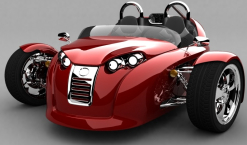
Throwing it into Reverse
By Design Engineering staff
General Automotive 3D scanner transportationQuebec carmaker uses 3D scanning to produce 'hot rod with sex appeal'

Boucherville, Que.-based Campagna Motors (formerly known as Cirbin Motors) specializes in the development and manufacturing of three-wheeled roadster-type vehicles to provide the automotive market with fun, style and performance. After several years of development and market feedback, co-founders André Morissette and David Neault look to “conquer the world by being creative, innovative, motivated and making niche products.”
Their first model was the V-13R, with hot-rod styling and powered by the Harley-Davidson Liquid-cooled Revolution 60° V-Twin engine. “The demand for these vehicles is coming from all parts of the world, and we intend to build a great reputation for quality, innovation and boldness in design,” Morissette says.
In order to stay ahead of the curb, Campagna looked for a timesaving scanning solution given they had a very tight timeframe dictated by the market it wanted to break into. While attending a major American tradeshow, they came across the Handyscan 3D handheld, self-positioning laser scanner by Levis, Que.-based Creaform. After meeting with Creaform and discussing their needs, Campagna decided to turn to their expertise.
The first phase involved the scanning of the company’s very first handmade body with the Handyscan EXAscan (a step up in resolution from Creaform’s previous REVscan model). Creaform was also in charge of scanning the surfaces, the seats and other components of the car in order to create CAD files that would eventually be used in the V13R’s development and large-scale production.
The scanning process used position targets (dots) on or around the parts. “When a camera sees a minimum of three dots, it triangulates exactly like a GPS system and projects a cross laser beam on the surface,” says David Gagné, a mechanical engineer and program director for Creaform. It generates an STL file (not a cloud of points) that he says is compatible with all major 3D CAD programs. However, STLs are made of triangles, so for sophisticated surfaces, it’s used as a shell on which to create the surface.
Campagna’s engineers also needed the STL files of the Harley Davidson engine in order to measure its overall dimensions in the chassis to determine the position of the car’s various components’ interfaces. The engine was subsequently shipped to Creaform’s workshop to be scanned.
The data collected have been used to create realistic renderings of the engine integrated into the chassis. Among other things, these files have been used to develop Campagna’s marketing campaign. The gain in time enabled them to speed up the development process of both the prototype and the final product. In the end, they met their deadlines and took advantage of the momentum in this narrow market slot.
